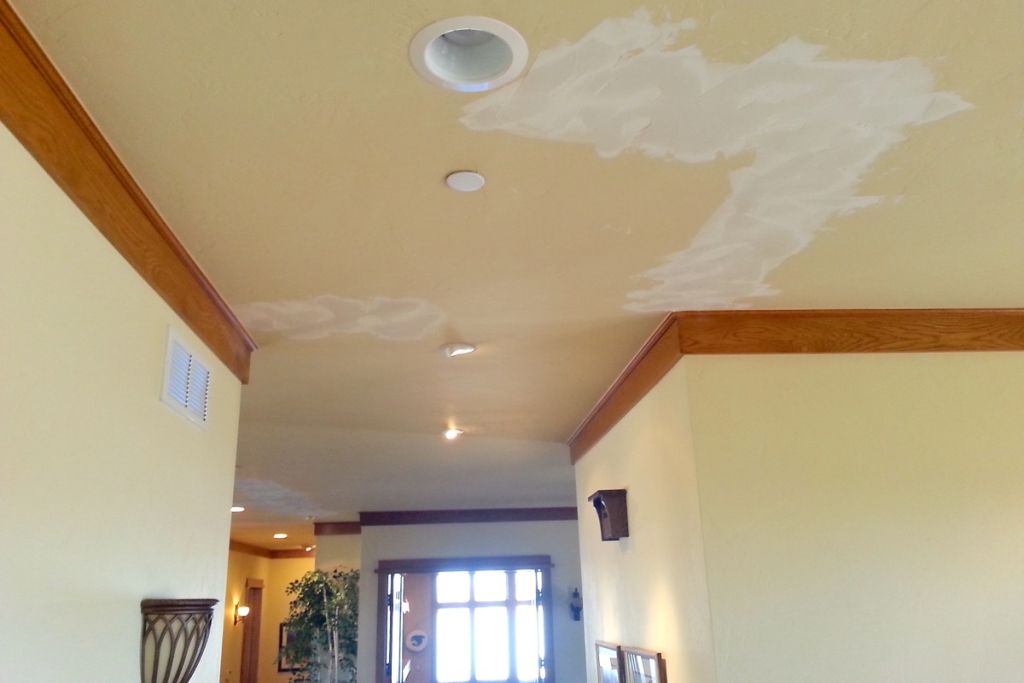Sometimes circumstances beyond our control can cause great damage to a home. If you’ve had a flood or fire (both common occurrences in Colorado these past few years!), you realize that even if your house is not destroyed, there can be quite a lot of damaged walls. I’ve done a lot of drywall repair for houses that have been damaged by fire and water, and the following tips can help you evaluate the extent of the damage in your home.
Water-Damaged Drywall
Depending on where the water is entering the room, there can be quite a lot of drywall damage. Be careful if you attempt to cut out any of the affected areas yourself, as there could be wiring immediately behind it that you may puncture or cut! This may be best left to a professional – I can determine where the damage is and how best to remove the affected wallboard.
Ceilings – Take a look at the ceiling of the room:
- Bulging – Is there an area of the ceiling that’s bulging noticeably downwards? There may be a pool of water building up above the drywall here. Get a 5-gallon bucket, then (ensuring you’re not directy underneath!) punch through the lowest part of the bulge with a large 10d nail or drill bit. Any trapped water may drain through and relieve the pressure on the ceiling drywall.
- Dimples – Do you see dimples where the drywall has pulled through the nails or screws and is sagging downwards? You may have an imminent ceiling collapse from that heavy, soaked sheetrock pulling off the joists.
- Cracking – If you don’t see the drywall drooping, but you still see uneven cracks or ruler-straight cracking, you have a problem – the straight cracks are typically a sign that the drywall tape has come off the drywall because of water damage (this symptom is also known as “popped tapes”).
Walls – Especially in basements or low areas of a house, if water has soaked drywall on the lower walls, the drywall may be so wet that you can easily press a thumbnail into the softened wallboard and leave an impression. If that’s the case, the drywall on the bottom of the wall may need to be cut out before it starts to get moldy and rotten. Mold can form in a few days given the right conditions, and especially if the initial green mold turns to the more dangerous black mold, the occupants of the house may be allergic to this and can become quite sick.
If you can, try to use fans and heating to create air movement and dry out the affected areas (this PDF file, “Assessing Water Damage – The Gypsum Association”, also describes assessing drywall damage and how to dry out moisture-affected drywall).
Sheetrock manufacturers recommend that if there is any doubt about whether moisture has soaked into the wallboard, it should be replaced. Drywall is just gypsum sandwiched in between layers of paper, and moisture can affect it dramatically – save yourself possible headaches by completely replacing affected walls.
Fire-Damaged Drywall
When you have a fire, you can often have damage first from the flames and heat, and then from the water that was sprayed to put out the fire.
Even if fire has not destroyed a room entirely, the resulting smoke from the fire can cause powerful lingering smells. Badly-burnt drywall may need to be cut off or removed entirely, and any blackened joists or studs can be painted with Killz or a similar smoke-sealing paint. Heat may also cause nails or screws to have popped through the drywall, and so there may be screws or nails that need to be removed and replaced.
Also, keep in mind that if the fire was hot enough, or if enough water was sprayed, the electrical system may have been compromised as well: insulation may have melted on the conductors, and there could be new short-circuit problems. It’s much easier to see if this damage occurred by removing the sheetrock and replacing it.

